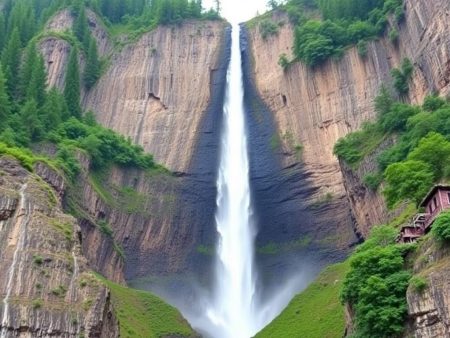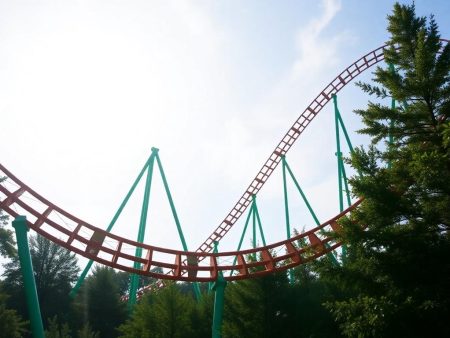Hóquei é um esporte onde velocidade, habilidade e força colidem no gelo, mas às vezes é o tamanho que chama a atenção. A NHL viu sua cota de atletas imponentes que usam sua altura incrível a seu favor, dominando o jogo de maneiras que outros simplesmente não conseguem. Esses jogadores não se destacam apenas por suas habilidades — eles literalmente se destacam dos demais.
Os fãs muitas vezes se maravilham com a forma como estes
O jogador mais alto da história da NHL: como a altura afeta as estrelas do hóquei e o desempenho no jogo
Hóquei é um esporte onde velocidade, habilidade e força colidem no gelo, mas às vezes é o tamanho que chama a atenção. A NHL viu sua cota de atletas imponentes que usam sua altura incrível a seu favor, dominando o jogo de maneiras que outros simplesmente não conseguem. Esses jogadores não se destacam apenas por suas habilidades — eles literalmente se destacam dos demais.
Converta a altura das pessoas, edifícios, montanhas e monumentos mais altos para m, pés e polegadas para comparar
0' 0" é igual a 0,0 cm ou 0,00 m.
Os fãs geralmente se maravilham com a forma como esses gigantes navegam pela pista com agilidade surpreendente enquanto usam seu alcance para controlar o disco e proteger a rede. Os jogadores mais altos da NHL trazem uma dinâmica única ao jogo, provando que a altura pode ser uma arma poderosa no mundo acelerado do hóquei profissional. Mas quem detém o título de mais alto entre eles? Vamos dar uma olhada mais de perto no jogador que levou essa distinção a novos patamares.
Quem é o jogador mais alto da NHL na história?
Zdeno Chara detém o recorde de jogador mais alto da história da NHL. Com 6 pés e 9 polegadas (206 cm) sem patins, sua altura proporcionou uma vantagem distinta no gelo. Nascido em Trenčín, Tchecoslováquia, Chara jogou 24 temporadas da NHL, exibindo habilidades defensivas inigualáveis.
A presença imponente de Chara aumentou sua habilidade de bloquear chutes, interromper jogadas e estender seu alcance durante batalhas de disco. Ele foi capitão do Boston Bruins por 14 temporadas e ganhou a Stanley Cup em 2011. Conhecido por seu poderoso slap shot, Chara estabeleceu um recorde na NHL All-Star Skills Competition de 2012 com um chute de 108,8 mph.
Sua carreira exemplar e estatura impressionante solidificam seu lugar como uma figura notável na história da NHL.
Jogadores mais altos da NHL atualmente
A NHL continua a apresentar atletas imponentes que usam sua altura excepcional para influenciar a jogabilidade. Esses jogadores se destacam tanto fisicamente quanto em suas contribuições para seus times.
Destacando os Líderes
Até agora, o defensor Tyler Myers está entre os jogadores ativos mais altos da NHL. Com 6 pés e 8 polegadas (203 cm) de altura, ele joga pelo Vancouver Canucks e é conhecido por sua forte presença defensiva e controle do disco. Outro jogador imponente é Tage Thompson, um ala de 6 pés e 7 polegadas (201 cm) do Buffalo Sabres, cuja altura e habilidade o tornam um formidável jogador ofensivo.
Outros jogadores, como Jamie Oleksiak do Seattle Kraken e Logan Stanley do Winnipeg Jets, também têm 6 pés e 7 polegadas (200 cm). Oleksiak utiliza seu tamanho para dominar em confrontos físicos, enquanto Stanley emprega seu alcance para interceptar jogadas e criar oportunidades para seus companheiros de equipe. Cada um exibe pontos fortes únicos ligados à sua altura extraordinária.
Jogadores notáveis para assistir
Mikey Anderson, um defensor em ascensão do Los Angeles Kings, com 6 pés e 7 polegadas (200 cm), está se tornando uma figura proeminente na NHL. Sua habilidade de combinar altura com agilidade defensiva fez dele um jogador a ser observado.
Brent Burns, embora um pouco mais baixo, com 6 pés e 5 polegadas (196 cm), continua significativo devido ao seu estilo de jogo impactante e versatilidade. Da mesma forma, Michael Rasmussen do Detroit Red Wings, com 6 pés e 6 polegadas (198 cm), mostrou crescimento consistente, melhorando suas habilidades defensivas e contribuições ofensivas. Seu desenvolvimento mostra como a altura pode ser um trunfo em funções variadas entre as equipes.
Impacto da altura na NHL
A altura molda significativamente a jogabilidade na NHL, oferecendo vantagens e desafios para os jogadores. Enquanto atletas mais altos frequentemente dominam defensivamente e fisicamente, eles também devem superar obstáculos únicos para ter sucesso.
Vantagens de ser alto
Jogadores mais altos comandam mais alcance no gelo, permitindo que interceptem passes, controlem discos soltos e desafiem jogadas adversárias de forma eficaz. Sua envergadura estendida prova ser valiosa na defesa contra ataques ofensivos rápidos e no bloqueio de linhas de arremessos. Por exemplo, defensores como Zdeno Chara e Tyler Myers usaram com sucesso sua altura para interromper jogadas e dominar confrontos físicos.
A altura aumenta a presença física, permitindo que esses jogadores lidem com as verificações corporais com maior estabilidade e distribuam golpes impactantes. Esse domínio físico é particularmente vantajoso durante as batalhas de disco ao longo das tabelas e na frente da rede. Além disso, atacantes altos como Tage Thompson usam seu tamanho para proteger o disco e criar oportunidades de pontuação, misturando fisicalidade com capacidades ofensivas.
Passadas mais longas dão aos patinadores mais altos uma vantagem para cobrir a pista de forma eficiente, o que aumenta sua mobilidade geral, apesar do tamanho. Essa combinação de alcance, força e comprimento da passada permite que atletas mais altos se destaquem em várias funções no gelo.
Desafios para jogadores mais altos
Jogadores mais altos geralmente enfrentam dificuldades com agilidade e mudanças rápidas de direção, pois membros mais longos e estruturas maiores podem dificultar os tempos de reação em cenários de alta intensidade. Equilibrar sua altura com velocidade e fluidez é essencial para manter uma jogabilidade eficaz em um ambiente de ritmo acelerado.
Outro desafio está na suscetibilidade a lesões. Maior massa corporal e altura podem levar a maior impacto em colisões, potencialmente intensificando o esforço físico. Medidas consistentes de condicionamento e prevenção de lesões são cruciais para o sucesso prolongado.
A fadiga também pode aumentar mais rápido devido às demandas de energia para manter a velocidade e a fisicalidade em turnos. Jogadores mais altos precisam administrar a resistência de forma eficaz sem comprometer a eficácia durante os jogos. Apesar desses desafios, muitos atletas altos como Jamie Oleksiak e Logan Stanley adaptaram seu jogo para maximizar seu potencial no gelo.
Momentos memoráveis dos jogadores mais altos da NHL
A liderança e as conquistas recordes de Zdeno Chara se destacam entre os momentos mais memoráveis da história da NHL. Como capitão do Boston Bruins, ele levou o time à vitória da Stanley Cup em 2011, tornando-se uma das figuras mais celebradas da liga. Seu slap shot recorde de 108,8 mph durante a NHL All-Star Skills Competition de 2012 continua sendo uma referência de potência e precisão.
Tyler Myers demonstrou seu impacto durante sua temporada de novato em 2009-10 com o Buffalo Sabres, onde ganhou o Calder Memorial Trophy por seu desempenho excepcional. Suas habilidades defensivas e capacidade de influenciar jogos exemplificam como jogadores altos podem dominar momentos cruciais.
Tage Thompson demonstrou seu potencial imponente em um jogo contra o Columbus Blue Jackets em 7 de dezembro de 2022. Marcando cinco gols em um jogo, ele empatou um recorde da franquia Sabres, colocando-o entre os jogadores de elite da história da NHL. Fãs e companheiros de equipe reconheceram o papel crítico que sua altura e habilidade desempenharam neste feito extraordinário.
Jamie Oleksiak, conhecido por sua fisicalidade, entregou momentos inesquecíveis por meio de suas contribuições defensivas e ofensivas. Seu destaque inclui um gol decisivo durante os playoffs da Stanley Cup de 2020 enquanto jogava pelo Dallas Stars, mostrando sua habilidade de entregar sob pressão.
Logan Stanley causou um impacto significativo em sua estreia nos playoffs da NHL em 19 de maio de 2021. Jogando pelo Winnipeg Jets, ele trouxe presença física e resiliência defensiva, provando seu valor em jogos de alto risco e solidificando sua reputação como um jogador confiável em situações cruciais.
Brent Burns, destacando-se por sua versatilidade, marcou um marco importante em sua carreira ao vencer o Norris Trophy em 2017, concedido ao melhor defensor da liga. Sua combinação de altura e habilidade permitiu que ele fosse uma força consistente no gelo, produzindo momentos de brilhantismo em jogadas defensivas e ofensivas.
Conclusão
A altura provou ser um divisor de águas na NHL, oferecendo aos jogadores vantagens únicas que podem moldar suas carreiras e influenciar o esporte. Das conquistas lendárias de Zdeno Chara às estrelas em ascensão que continuam a deixar sua marca, jogadores altos mostraram como o tamanho, quando combinado com habilidade e estratégia, pode dominar o gelo. Embora existam desafios, esses atletas se adaptaram e se destacaram, deixando os fãs impressionados com suas performances. O legado de jogadores imponentes da NHL é uma prova das diversas maneiras pelas quais os atributos físicos podem aprimorar o jogo, tornando o hóquei ainda mais emocionante de assistir.
Perguntas frequentes
Quem é o jogador mais alto da história da NHL?
Zdeno Chara detém o recorde de jogador mais alto da história da NHL, com 2,06 m (6 pés e 9 polegadas) sem patins.
Como a altura beneficia os jogadores de hóquei na NHL?
A altura proporciona vantagens como maior alcance para interceptar passes, melhor jogo defensivo e uma forte presença física durante disputas de gols e disputas de disco.
Existem desafios para jogadores altos no hóquei?
Sim, jogadores altos podem enfrentar problemas de agilidade, maiores riscos de lesões devido a estruturas maiores e desafios de resistência que exigem condicionamento eficaz.
Quais jogadores atuais da NHL estão entre os mais altos?
Jogadores altos notáveis na NHL hoje incluem Tyler Myers (2,03 m), Tage Thompson (2,01 m), Jamie Oleksiak (2,01 m) e Logan Stanley (2,01 m).
Quais são alguns destaques da carreira de Zdeno Chara?
Zdeno Chara foi capitão do Boston Bruins por 14 temporadas, ganhou a Stanley Cup em 2011 e estabeleceu o recorde de tacada mais difícil (108,8 mph) em 2012.
Como os jogadores altos da NHL se adaptam para superar seus desafios?
Eles se concentram em melhorar a agilidade, controlar a resistência, manter o condicionamento físico e refinar suas habilidades para maximizar seu potencial físico e técnico.
Quais são alguns momentos memoráveis envolvendo jogadores altos da NHL?
O jogo de cinco gols de Tage Thompson, a vitória de Tyler Myers no Troféu Calder e a vitória de Zdeno Chara na Stanley Cup são conquistas notáveis de jogadores altos.
Quem são alguns jogadores altos e versáteis da NHL?
Brent Burns, com 1,95 m, é conhecido por sua versatilidade e ganhou o Troféu Norris em 2017 por suas habilidades defensivas e ofensivas excepcionais.
Como a altura ajuda nas oportunidades de pontuação?
A altura permite que os jogadores ganhem batalhas de disco, criem espaços abertos e utilizem seu alcance para atrapalhar os oponentes e executar jogadas de forma eficaz.
A altura é mais vantajosa para defensores ou atacantes no hóquei?
A altura é crucial para ambas as funções. Os defensores se beneficiam do alcance e das habilidades de bloqueio, enquanto os atacantes usam seu tamanho para controlar o disco e criar oportunidades de pontuação.





